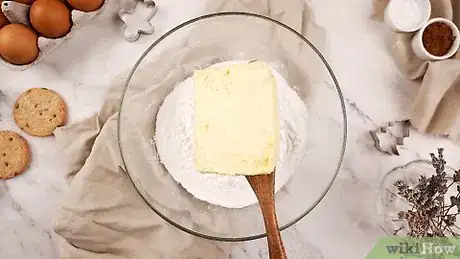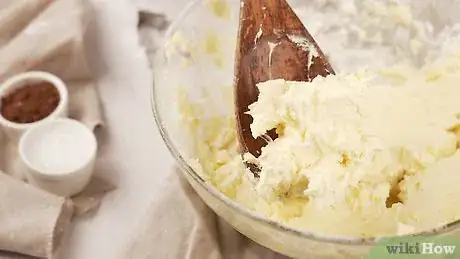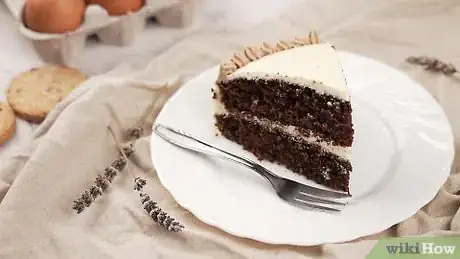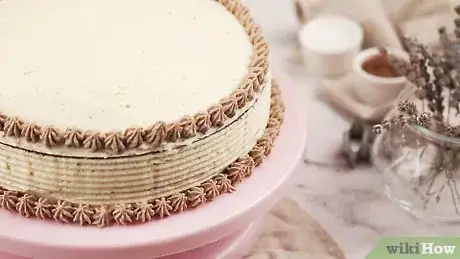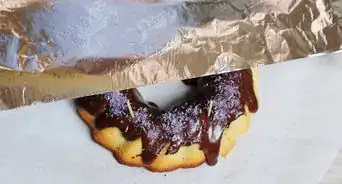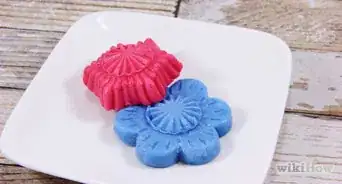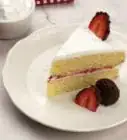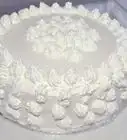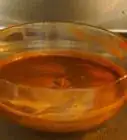This article was co-authored by Quynh La and by wikiHow staff writer, Jessica Gibson. Quynh La is a Professional Baker and the Owner of Sugar Bakery & Cafe in Seattle, Washington. With over seven years of experience, she specializes in baking cakes, cookies, croissants, and bread. Quynh holds an AAS in Culinary Arts from South Seattle College and a second AAS in Specialty Desserts & Bread from Seattle Central College.
There are 8 references cited in this article, which can be found at the bottom of the page.
This article has been viewed 15,151 times.
You've made the batter and baked your cakes, but you're not finished yet! Frosting the cake is easy, but you might be wondering how to get a smooth finish or prevent the frosting from soaking into the cake. We've got you covered—read on for answers to some of your most pressing cake conundrums.
Steps
Which type of buttercream is best for covering a cake?
-
1Use American buttercream for frosting that's the simplest to make.[1] This is a fantastic frosting if you're new to baking or are short on time. Simply beat softened butter with powdered sugar to make a thick, fluffy frosting that clings to your cake.[2]
- Since it's so sweet, it's hard to add flavors like fruit preserves or caramel to American buttercream. It also tends to be a little grainy, but it has a classic buttery flavor.
-
2Try Swiss meringue buttercream for velvety frosting that's easy to pipe. For this buttercream, heat egg whites and sugar before you beat them. Then, mix in softened butter to make a silly frosting that's easy to spread or pipe onto your cake.[3]
- The egg whites are safe to eat since you heat them with sugar.
- Swiss meringue buttercream is a great choice if you want to flavor it with jam, caramel, flavor extracts, or melted chocolate. It's also perfect for frosting and piping since it's so smooth.
Advertisement -
3Make Italian meringue buttercream for the smoothest frosting. Italian meringue is a lot like swiss meringue but it holds up better in warm temperatures. Start by whipping egg whites and making a sugar syrup. You'll slowly pour the syrup into the whipped eggs before you add softened butter.[4]
- Italian meringue buttercream is a great choice if you want to prep the cake in advance. The meringue helps stabilize the buttercream so you can frost and store your cake for up to 3 days in advance.[5]
How do I get the buttercream to stick to the cake?
-
1Chill the cake for 2 hours before you frost it. It's hard to be patient, but wait! If you frost the cake before it's cooled, the butter in the frosting will melt and soak into your cake. Plan on chilling the cake for 2 hours before you cover it with buttercream.[6]
- Let the cake layers cool to room temperature and wrap them in plastic wrap before you stick them in the fridge. You can chill them overnight as long as they're wrapped well.
-
2Spread a really thin layer of frosting to lock in the crumbs. To do a crumb coat, brush away loose crumbs with a pastry brush. Stir a 1 tablespoon (15 ml) of milk into 1/2 cup (56 g) of your buttercream to loosen it. Then, use an offset spatula to spread it onto the tops and sides of your cakes. Pop them into the fridge to chill for 15 minutes so the buttercream hardens.[7]
- You may have heard of a crumb coat—this is just a super-thin coating of buttercream that traps loose crumbs. It also gives your buttercream something to really stick to.
- If you're frosting a chocolate cake, you might want to do an extra crumb coat since dark cake crumbs can show up easily in light-colored buttercream.
How can I decorate the cake with buttercream?
-
1Drag a cake comb across the sides to give your frosting a unique texture. Cake combs are plastic scrapers that have designs along the edge. Once you frost your cake, hold the cake comb vertically against the side of the cake and spin the turntable slowly as you press the comb against it to make ridges, stripes, or cool textures.[9]
- If you don't want to buy a cake comb, look for things you already have in your kitchen. Drag the tines of a fork along the sides to make thin ridges or swirl the back of a spoon along the frosting to make fun swoops.
-
2Use a piping bag with different tips to make rosettes, ruffles, and scallops. While a smooth cake is striking, it's fun to play with buttercream accents. Fill a piping bag with your buttercream and choose a tip based on what design you want to make. Use a small round tip if you want to pipe words, for instance, or use a leaf tip to give your cake floral decorations.[10]
- To practice your piping skills, lay a piece of parchment paper on a baking sheet and try out different tips before you decorate the cake itself.
Expert Q&A
-
QuestionHow do you fix stiff American buttercream?
 Quynh LaQuynh La is a Professional Baker and the Owner of Sugar Bakery & Cafe in Seattle, Washington. With over seven years of experience, she specializes in baking cakes, cookies, croissants, and bread. Quynh holds an AAS in Culinary Arts from South Seattle College and a second AAS in Specialty Desserts & Bread from Seattle Central College.
Quynh LaQuynh La is a Professional Baker and the Owner of Sugar Bakery & Cafe in Seattle, Washington. With over seven years of experience, she specializes in baking cakes, cookies, croissants, and bread. Quynh holds an AAS in Culinary Arts from South Seattle College and a second AAS in Specialty Desserts & Bread from Seattle Central College.
Professional Baker Put your buttercream somewhere warm! Fill a big pot with hot water and set your buttercream on top of that to melt the butter slightly. This will help your butter cream be light and fluffy, rather than stiff, cold, and chunky.
Put your buttercream somewhere warm! Fill a big pot with hot water and set your buttercream on top of that to melt the butter slightly. This will help your butter cream be light and fluffy, rather than stiff, cold, and chunky. -
QuestionWhat makes buttercream stiff?
 Quynh LaQuynh La is a Professional Baker and the Owner of Sugar Bakery & Cafe in Seattle, Washington. With over seven years of experience, she specializes in baking cakes, cookies, croissants, and bread. Quynh holds an AAS in Culinary Arts from South Seattle College and a second AAS in Specialty Desserts & Bread from Seattle Central College.
Quynh LaQuynh La is a Professional Baker and the Owner of Sugar Bakery & Cafe in Seattle, Washington. With over seven years of experience, she specializes in baking cakes, cookies, croissants, and bread. Quynh holds an AAS in Culinary Arts from South Seattle College and a second AAS in Specialty Desserts & Bread from Seattle Central College.
Professional Baker The temperature of the butter! You have to start with room temperature butter, or else the frosting will become very stiff.
The temperature of the butter! You have to start with room temperature butter, or else the frosting will become very stiff.
References
- ↑ Quynh La. Professional Baker. Expert Interview. 11 March 2022.
- ↑ https://www.thekitchn.com/baking-school-day-7-buttercream-222485
- ↑ https://www.thekitchn.com/baking-school-day-7-buttercream-222485
- ↑ https://www.thekitchn.com/baking-school-day-7-buttercream-222485
- ↑ https://www.thekitchn.com/baking-school-day-7-buttercream-222485
- ↑ https://cooking.nytimes.com/guides/20-how-to-frost-a-cake
- ↑ https://cooking.nytimes.com/guides/20-how-to-frost-a-cake
- ↑ https://www.bbc.co.uk/food/techniques/ice_cake_buttercream
- ↑ https://youtu.be/tGo1y-F5J2o?t=23
About This Article
If you want to cover a cake with buttercream and get to stick, there are few things you can do! First off, the type of buttercream you’re using is important. American buttercream is the simplest to make. Swiss meringue buttercream is great for velvety frosting and is the easiest type to pipe. Italian meringue buttercream makes the smoothest frosting. To get your buttercream to stick to your cake, first chill the cake for 2 hours before you frost it. Then, spread a very thin layer of frosting onto the cake to lock in the crumbs. This is called the crumb coat. Next, Use an offset spatula to evenly spread buttercream onto the top and sides. Set 1 cake layer on a turntable and scoop 1 cup (112 g) of buttercream frosting onto the top. Spread the frosting to the edge of the layer with an offset spatula. Set your other cake layer on top and put the rest of your frosting on top. Then, spread the frosting across the surface and down the sides of the cake.
